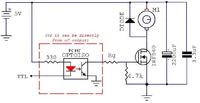mengghee
Full Member level 3

- Joined
- Nov 29, 2005
- Messages
- 163
- Helped
- 8
- Reputation
- 16
- Reaction score
- 5
- Trophy points
- 1,298
- Location
- United Kingdom
- Activity points
- 3,105
power mosfet datasheet
Hiye everybody,
I have attached a datahsheet here and i am just wondering if anybody can help me understanding the IRF530 Datasheet. basicly my question is, in order to turn on the mosfet, what voltage should i apply to the gate ? and what sort of current ? and where can i find it in the datasheet ? thank you very much.
regards,
mengghee
Hiye everybody,
I have attached a datahsheet here and i am just wondering if anybody can help me understanding the IRF530 Datasheet. basicly my question is, in order to turn on the mosfet, what voltage should i apply to the gate ? and what sort of current ? and where can i find it in the datasheet ? thank you very much.
regards,
mengghee







